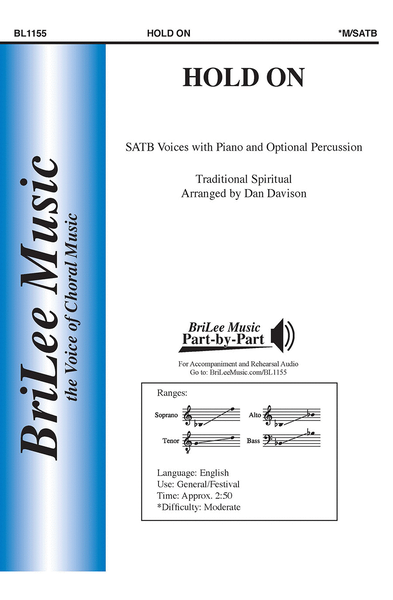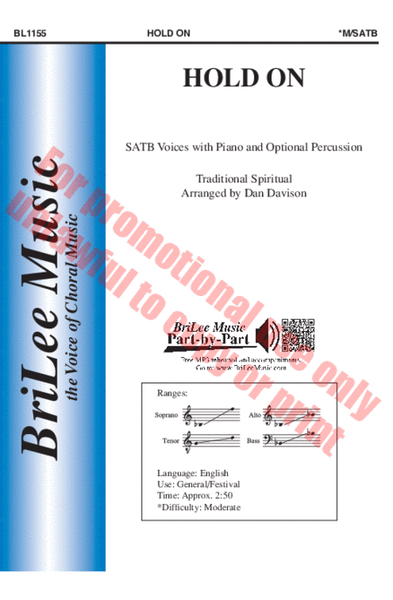Details
Description
SKU: CF.BL1155
Composed by Traditional Spiritual. Arranged by Dan Davison. Sws. Octavo. 16 pages. Duration 2 minutes, 50 seconds. BriLee Music #BL1155. Published by BriLee Music (CF.BL1155).UPC: 672405010061. 6.875 x 10.5 inches. Key: F major. English. Traditional Spiritual.
With tremendous rhythmic variety, vitality, and even counterpoint, Davison creates a frenetic energy in this beloved spiritual that comes out of the slave culture of the American south. Ranges are perfect for emerging mixed choirs in the middle and developing high school levels. Add the optional brake drum for greater effect. A MUST SING!.
Hold On is a spiritual that comes out of the slave culture of the American South. Most spirituals are considered to be "traditional," meaning that the composer is not known. Rather, the song was passed from one generation to the next through oral tradition. While most spirituals refer to topic of religious faith, some others include coded meanings that would help slaves who were escaping to freedom in the North. The piece calls for a brake drum. This instrument is actually a heavy metal disk brake from a car that is hit with a hammer. Some school bands have this instrument in their percussion cabinet. If an actual disk brake cannot be found, you might try using a large, cast-iron fry pan and hammer. Whatever instrument is chosen, the outcome should be a metallic sound that sounds like a railroad tie being driven into the ground. The idea to be conveyed is that keeping your faith requires hard, consistent work. There are plenty of places in the song where singers are asked to hold notes for two whole notes. In all these cases, do not make the mistake of holding a single dynamic for the entire note. Instead, all long notes should have a dynamic arch added to them. Letter E is all about the counterpoint. The idea in counterpoint is to bring out your part when your part is moving, but then to soften on the held notes, providing an opportunity for the other part to be spotlighted. In general, articulations in this piece are to be exaggerated. Staccatos are to be very short, and more importantly, accents are to be sung so as to "pop." Likewise, dynamics should be exaggerated, especially the dynamic change at letter G. Care has been taken to limit the ranges in the tenor and bass parts, making this song accessible for a wide range of choirs.
Hold On is a spiritual that comes out of the slave culture of the American South. Most spirituals are considered to be “traditional,” meaning that the composer is not known. Rather, the song was passed from one generation to the next through oral tradition. While most spirituals refer to topic of religious faith, some others include coded meanings that would help slaves who were escaping to freedom in the North.The piece calls for a brake drum. This instrument is actually a heavy metal disk brake from a car that is hit with a hammer. Some school bands have this instrument in their percussion cabinet. If an actual disk brake cannot be found, you might try using a large, cast-iron fry pan and hammer. Whatever instrument is chosen, the outcome should be a metallic sound that sounds like a railroad tie being driven into the ground. The idea to be conveyed is that keeping your faith requires hard, consistent work.There are plenty of places in the song where singers are asked to hold notes for two whole notes. In all these cases, do not make the mistake of holding a single dynamic for the entire note. Instead, all long notes should have a dynamic arch added to them.Letter E is all about the counterpoint. The idea in counterpoint is to bring out your part when your part is moving, but then to soften on the held notes, providing an opportunity for the other part to be spotlighted.In general, articulations in this piece are to be exaggerated. Staccatos are to be very short, and more importantly, accents are to be sung so as to “pop.” Likewise, dynamics should be exaggerated, especially the dynamic change at letter G.Care has been taken to limit the ranges in the tenor and bass parts, making this song accessible for a wide range of choirs.
Hold On is a spiritual that comes out of the slave culture of the American South. Most spirituals are considered to be “traditional,” meaning that the composer is not known. Rather, the song was passed from one generation to the next through oral tradition. While most spirituals refer to topic of religious faith, some others include coded meanings that would help slaves who were escaping to freedom in the North.The piece calls for a brake drum. This instrument is actually a heavy metal disk brake from a car that is hit with a hammer. Some school bands have this instrument in their percussion cabinet. If an actual disk brake cannot be found, you might try using a large, cast-iron fry pan and hammer. Whatever instrument is chosen, the outcome should be a metallic sound that sounds like a railroad tie being driven into the ground. The idea to be conveyed is that keeping your faith requires hard, consistent work.There are plenty of places in the song where singers are asked to hold notes for two whole notes. In all these cases, do not make the mistake of holding a single dynamic for the entire note. Instead, all long notes should have a dynamic arch added to them.Letter E is all about the counterpoint. The idea in counterpoint is to bring out your part when your part is moving, but then to soften on the held notes, providing an opportunity for the other part to be spotlighted.In general, articulations in this piece are to be exaggerated. Staccatos are to be very short, and more importantly, accents are to be sung so as to “pop.” Likewise, dynamics should be exaggerated, especially the dynamic change at letter G.Care has been taken to limit the ranges in the tenor and bass parts, making this song accessible for a wide range of choirs. .


 Share
Share